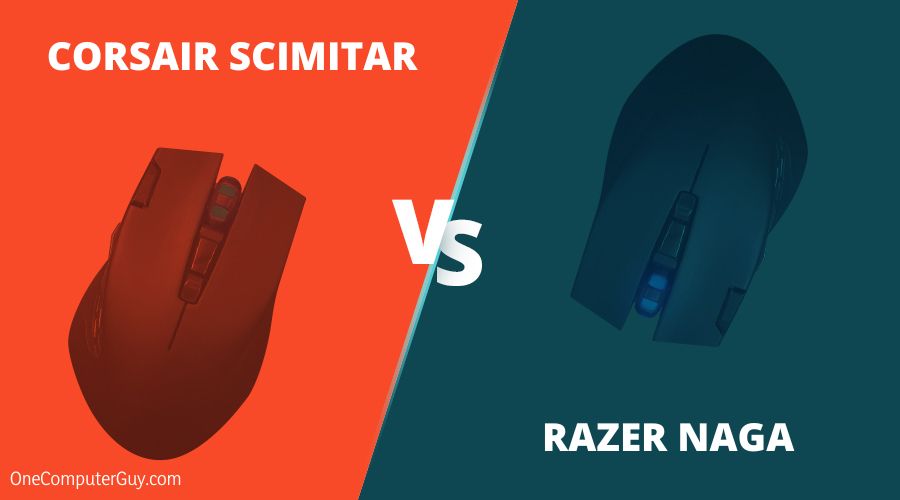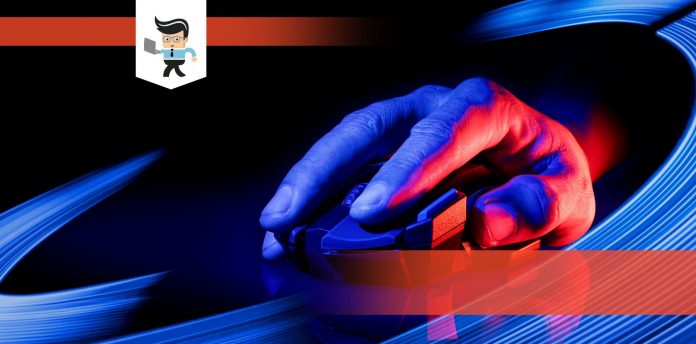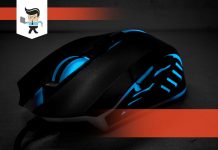The Razer Naga vs Corsair Scimitar mice are two customizable, programmable gaming mice with two different feature sets which will appeal to different users.
 The Naga offers the ability to swap out the left panel of the mouse and adjust whether there are two, seven, or twelve programmable buttons within a thumb’s reach. The Scimitar offers the ability to move the 12 key macro block, and is compatible for use with Mac systems.
The Naga offers the ability to swap out the left panel of the mouse and adjust whether there are two, seven, or twelve programmable buttons within a thumb’s reach. The Scimitar offers the ability to move the 12 key macro block, and is compatible for use with Mac systems.
Both are nearly the same size and weight, with similar ergonomic designs that make them comfortable to use for all day general-purpose computing as well as extended gaming sessions, but based on user need, one will be better than the other.
Contents
Comparison Table
| Mous | Key Specifications |
| Corsair Scimitar |
|
| Razer Naga |
|
1. Razer Naga
The Razer Naga Trinity is a customizable gaming mouse which allows you to set up your own configurations with three side panels that can be swapped out to get you two, seven, or twelve programmable buttons within easy reach of your right thumb. It’s an ideal mouse for anyone who requires different configurations for multiple styles of gameplay.
Pros:
- Versatile, interchangeable side panels
- Easily customizable using Razer’s Synapse support software
- Software is easy to use, including changing the RGB lighting of the mouse
- Reasonably priced
- Space for all fingers on the mouse itself
Cons:
- Mouse dimensions themselves cannot be adjusted
- Layout of the buttons can be hard to master for new users
- Wired-only, unlike previous versions of the Naga which offered a wireless option
- Doesn’t glide as nicely as the Scimitar on the mousepad
– Specs:
- Razer 5G 16,000 DPI Optical Sensor
- 3 interchangeable left-side plates to accommodate 2, 7, or 12-button configurations
- Razer Synapse support software
- Razer mechanical mouse switches
- 6 Foot/2 meter cable
- Dimensions: 4.69 inches x 2.93 inches x 1.69 inches (119.1 mm x 74.4 mm x 42.9 mm)
- Weight 4.28 ounces (120g)
The Razer Naga size is slightly smaller than the Corsair Scimitar by a few fractions of a millimeter in length and height, and by about three millimeters in width. These are not significant size differences, and if you find your hand is too small for one, it will probably be too small for the other as well. However, the smaller width of the Razer Naga, combined with its clearly defined macro keys, may be the difference between a comfortable mouse and an unusable one.
– Design
The Naga features a unique design with three optional side panels to make it suitable for all types of games from FPS to MMOs, while the Corsair features a more traditional MMO style with 12 additional buttons on the side. The Naga is a bit smaller, though people with small hands may still have a difficult time getting a comfortable grip.
– Buttons
The design of the button grid on the Naga simply feels better than that on the Corsair Scimitar, despite featuring significantly smaller buttons. On the Naga, it is easy to reach all 12 buttons comfortably without needing to shift the grip on the mouse. The fact that each of the buttons is tilted slightly makes it even easier to distinguish them, and you can feel the distinct edges of each button with your thumb.
The left and right button main buttons are almost effortless to click. The light switches offer very little resistance and while some don’t necessarily find this to be a problem, they’re much quieter and lighter than the switches used on previous versions of the Naga mice. If you prefer more robust switches, then you may not like the feel of the Naga’s clicks. This, however, is mainly a matter of preference.
The side buttons of the Naga can be inconsistent compared to older Naga mice, which can be explained by the fact that the buttons themselves are part of a separate section of the mouse, compared to the cohesive design of earlier Naga mice. On the macro pad in particular, the 11 and 12 keys have a tendency to feel softer and not have the same “clicky” feel as the rest.
– Features
One of the features of the Razer Naga is the synapse software used to change the key bindings, colors, and sensitivity. The Razer Synapse program has an intuitive interface which allows the user to easily make adjustments to their Razer devices.
The Razer Naga Limited Edition Trinity mouse takes a unique approach to the diverse needs of the consumer, from gaming to general everyday use. The interchangeable side panels facilitate a customizable number of programmable buttons for the user to set up to their liking.
– Performance
The flexibility of the side panel is one of the major advantages to choosing the Naga. Unfortunately for Apple-lovers out there, the Naga mouse is not compatible with the Mac system.

The 16,000 DPI sensor is capable of detecting minute movements so that all the small corrections done in something like League of Legends are easy to complete. Lightweight switches make for lightning-fast clicks.
2. Corsair Scimitar
The Corsair Scimitar is a multifunctional gaming mouse with additional buttons on the left side that can be tied to the top row of keys from “1” to “=” for MMO and MOBA games, or programmed as macro buttons. The Scimitar boasts a high-performance sensor, adjustability in the macro bank, and premium materials. It’s a good gaming mouse for anyone who needs the ability to add commands to their mouse instead of keyboard. If you are looking for a mouse like Razer Naga without the same price tag, the Corsair Scimitar is a good option.
Pros:
- Well-constructed from high quality materials
- Macro button bank on left side of mouse has adjustable positions
- 18,000 DPI sensor (even though no one ever has their sensitivity turned up that high)
- Comfortable, ergonomic design
Cons:
- Doesn’t work well for people who prefer to use a claw grip over a palm grip
- Macro buttons are close together and hard to distinguish from one another during use.
- Polling rate cannot be adjusted in the Corsair mouse’s software
- iCUE software for Corsair is not as intuitive as Razer Synapse
- A little tricky to use when playing first person shooter games
– Corsair Scimitar Specs:
- 4 Programmable RGB zones
- 9 foot (1.8 meter) cable
- Dimensions: 7 inches x 3 inches x 1.7 inches (119.4 mm x 77 mm x 43.1 mm)
- Weight: 4.3 ounces (122g)
- 18,000 DPI optical sensor
The Corsair Scimitar is slightly larger and heavier than the Razer Naga. The Razer Naga size could be a deciding factor for some people, even though the margin between the Naga and the Scimitar is incredibly fine. If your hands are on the smaller side, a few millimeters may be the difference between you easily reaching the macro buttons, and being frustrated at their orientation and position.
– Design
The Scimitar has a curved design that fits nicely in the hand, twelve buttons arranged in a thumb grid on the left side of the mouse, and there are skates on the bottom of the mouse to help it glide across the mousepad. The skates on the bottom of the Corsair Scimitar perform better than those on the Naga, which don’t slide quite as smoothly.
– Buttons
Like the Naga, the Corsair Scimitar comes with 12 side buttons accessible via the user’s right thumb. The buttons on the Corsair Scimitar are larger than those on the Naga, but then in order for them all to fit on the side of the mouse, they are very flush with one another.
The Naga side buttons are designed with a different shape to them, and enough space between each one that you can feel the edge with your thumb and know which one you are hitting, even if you aren’t on the home row with its telltale bump. The Scimitar’s side buttons are so level and close together that you can hardly tell what you’re pressing, especially within the same row.
The buttons on the Corsair Scimitar are set slightly higher than those on the Naga as well. However, the increased height of the Scimitar buttons turns out to be a hindrance for anyone with smaller hands, because the thumb may not actually be long enough to comfortably reach all of the rows of buttons without shifting the grip. Even though the button grid is somewhat adjustable forward and backward, it may not matter depending on the size of the user’s hand.
All of the buttons themselves, in spite of the side grid’s unfortunate positioning, are great. The mouse is made with quality, responsive Omron switches with a good tactile feel to them, and all of the side buttons feel nice and “clicky.” The buttons offer a little resistance and good feedback while also being light enough to easily actuate.
– Shape
The shape of the Corsair Scimitar is ergonomic and very comfortable. Evidently, Corsair was heavily inspired by the Naga when designing their shape for the scimitar, as it feels mostly the same. The Corsair Scimitar also features an extra rubber grip on the section where you rest your ring finger during use and prevents slipping. This is a nice added detail which is missing from the Naga mice which sport a hard plastic shell.
– Performance
For MMO games where it is convenient to assign macros to the mouse’s side buttons, or you are using the mouse buttons as an alternative to consistently pressing the number keys on the keyboard, the Corsair is a good mouse to use. If you find that you are having issues clicking the right macros button due to the spacing, you can space out the macros you assign so that no two of them are right next to one another.

To setup Corsair Scimitar you have to use the Corsair software iCUE which does not have as nice an interface as the Razer Synapse program for rekeying the Naga and changing its settings.
Conclusion
The Razer Naga, while having a lower DPI than the Scimitar, is a better performer overall.
In terms of accessibility to the user for programming the modifiable button functions, the Razer synapse program is easier to use, the changeable side panel with different button configurations make the mouse itself far more customizable than the Scimitar, and the buttons of the macro block in the Scimitar are flush and close together, making them hard to distinguish from one another during use.
The Razer Naga is the winner.







